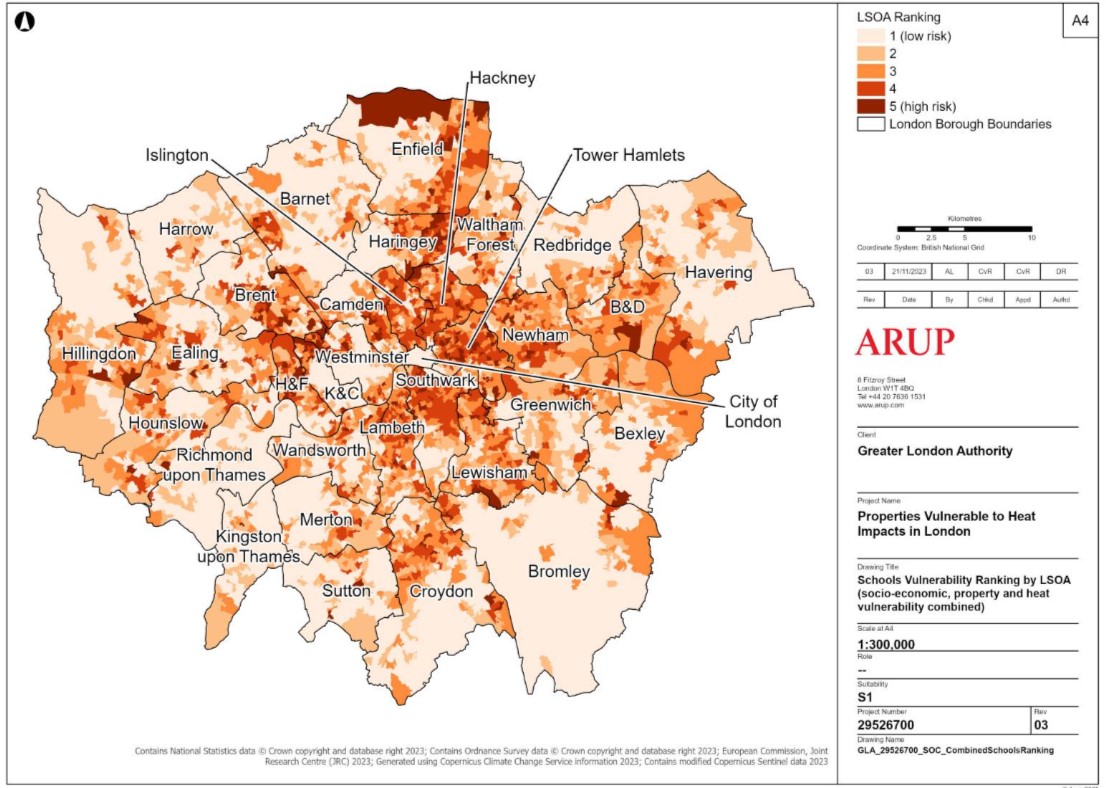Report commissioned by Mayor of London identifies the neighbourhoods and properties most at risk from rising temperatures, in the wake of the hottest year ever recorded.
The UK is getting hotter, with temperatures above 40°C recorded for the first time in 2022. The Met Office concluded last year that we may well face such temperatures more often in future. This will have profound impacts on the physical environment and on people, with consequences beyond the health and social care system.
Even fit and healthy people are at risk in such heatwaves. Vulnerable people are disproportionately affected.

Heat risk map of London, courtesy of Arup
Understanding how rising heat will affect our communities is essential to efforts to plan for and mitigate problems. That’s why the Mayor of London commissioned global sustainable development consultancy Arup to produce the new report.
‘Properties vulnerable to heat impacts in London – prioritisation for adaption interventions’ provides data on the areas of London most at risk from heat. It also shows direct correlation between socio-economic vulnerabilities and heat risk.
London faces particular challenges because of what’s known as the urban heat island (UHI) effect. Materials such as concrete and metal, with which most of our buildings are constructed, absorb heat during the day and emit it at night – so the city and its people have less change to cool off and recover after a hot day.
Heat and emissions from cars, air conditioning units and other sources can exacerbate the impact of UHI.
The report finds that:
- Schools must at risk from the impact of heat are in Islington, Hackney and Tower Hamlets.
- Hospitals and care homes most at risk are those in central London, due to UHI.
- Residential properties most at risk are again those in central neighbourhoods, such as Hackney, Tower Hamlets, Islington and Camden
Not all of this is down to UHI. The report notes the correlation of socioeconomic and property vulnerabilities to the boroughs most at risk from heat. One reason is that these boroughs tend to have a higher concentration of flats, with more densely crowded living space more at risk from heat.
It’s makes for sobering reading – but can also guide what Londoners do next. It’s been published alongside the independent London Climate Resilience Review’s interim report, also commissioned by the Mayor of London. Together, these studies can inform how action is prioritised.
Damien McCloud, Arup’s Geospatial, Earth Observation and Visualisation leader for the UK, India, Middle East and Africa region, says: ‘London is getting hotter, with the design of our urban capital contributing to how heat impacts different spaces. We produced this report to quantify which areas and properties are most vulnerable. It is vital that these findings inform GLA’s efforts and broader policy-making so that meaningful interventions can be put in place to protect Londoners in buildings most at risk of overheating. At the same time, London needs a holistic approach to reducing the impact of the different consequences of climate change.’
Shirley Rodrigues, Deputy Mayor of Environment and Energy, Greater London Authority, adds: ‘For some time now we’ve known London is getting hotter – and we need to urgently future-proof the capital against the impacts of a changing climate.
‘The Mayor commissioned this report to help us prioritise the areas and public services which most need adaptation in the face of extreme heat. It’s unacceptable that people living in London’s most deprived areas are the most vulnerable to overheating. This week the Independent London Climate Resilience Review, which was commissioned in June, published its interim report detailing the steps we are urgently taking to protect all Londoners from the impact of climate change, now and in the future. If we make bold choices now, we can build a better, greener and safer London for all.’
In related news:
















Leave a Reply